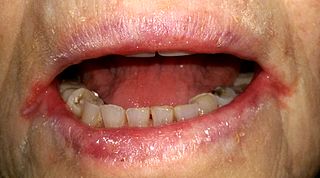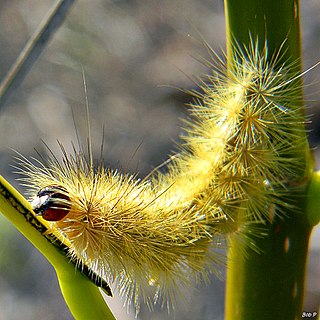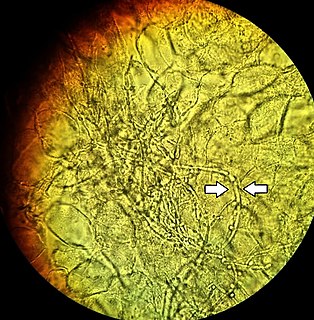
Candidiasis is a fungal infection due to any type of Candida. When it affects the mouth, in some countries it is commonly called thrush. Signs and symptoms include white patches on the tongue or other areas of the mouth and throat. Other symptoms may include soreness and problems swallowing. When it affects the vagina, it may be referred to as a yeast infection or thrush. Signs and symptoms include genital itching, burning, and sometimes a white "cottage cheese-like" discharge from the vagina. Yeast infections of the penis are less common and typically present with an itchy rash. Very rarely, yeast infections may become invasive, spreading to other parts of the body. This may result in fevers along with other symptoms depending on the parts involved.

Candida albicans is an opportunistic pathogenic yeast that is a common member of the human gut flora. It can also survive outside the human body. It is detected in the gastrointestinal tract and mouth in 40–60% of healthy adults. It is usually a commensal organism, but it can become pathogenic in immunocompromised individuals under a variety of conditions. It is one of the few species of the genus Candida that causes the human infection candidiasis, which results from an overgrowth of the fungus. Candidiasis is, for example, often observed in HIV-infected patients. C. albicans is the most common fungal species isolated from biofilms either formed on (permanent) implanted medical devices or on human tissue. C. albicans, C. tropicalis, C. parapsilosis, and C. glabrata are together responsible for 50–90% of all cases of candidiasis in humans. A mortality rate of 40% has been reported for patients with systemic candidiasis due to C. albicans. By one estimate, invasive candidiasis contracted in a hospital causes 2,800 to 11,200 deaths yearly in the US. Nevertheless, these numbers may not truly reflect the true extent of damage this organism causes, given new studies indicating that C. albicans can cross the blood–brain barrier in mice.

Candida is a genus of yeasts and is the most common cause of fungal infections worldwide. Many species are harmless commensals or endosymbionts of hosts including humans; however, when mucosal barriers are disrupted or the immune system is compromised they can invade and cause disease, known as an opportunistic infection. Candida is located on most mucosal surfaces and mainly the gastrointestinal tract, along with the skin. Candida albicans is the most commonly isolated species and can cause infections in humans and other animals. In winemaking, some species of Candida can potentially spoil wines.

Oral candidiasis, also known as oral thrush among other names, is candidiasis that occurs in the mouth. That is, oral candidiasis is a mycosis of Candida species on the mucous membranes of the mouth.

Angular cheilitis (AC) is inflammation of one or both corners of the mouth. Often the corners are red with skin breakdown and crusting. It can also be itchy or painful. The condition can last for days to years. Angular cheilitis is a type of cheilitis.

Esophageal candidiasis is an opportunistic infection of the esophagus by Candida albicans. The disease usually occurs in patients in immunocompromised states, including post-chemotherapy and in AIDS. However, it can also occur in patients with no predisposing risk factors, and is more likely to be asymptomatic in those patients. It is also known as candidal esophagitis or monilial esophagitis.

Chronic mucocutaneous candidiasis is an immune disorder of T cells, it is characterized by chronic infections with Candida that are limited to mucosal surfaces, skin, and nails. It can also be associated with other types of infections, such as human papilloma virus. An association with chromosome 2 has been identified.

Lymire is a genus of tiger moths in the family Erebidae. The genus was erected by Francis Walker in 1854.
Candidal onychomycosis is an infection of the nail plate by fungus caused by Candida. In one study Candida parapsilosis was the most common species; Candida albicans is also a common agent.

Vaginal yeast infection, also known as candidal vulvovaginitis and vaginal thrush, is excessive growth of yeast in the vagina that results in irritation. The most common symptom is vaginal itching, which may be severe. Other symptoms include burning with urination, a thick, white vaginal discharge that typically does not smell bad, pain during sex, and redness around the vagina. Symptoms often worsen just before a woman's period.
Candida blankii is a species of budding yeast (Saccharomycotina) in the family Saccharomycetaceae. The yeast may be a dangerous pathogen and resistant to treatment in human hosts. Research on the fungi has therapeutic, medical and industrial implications.
Lymire albipedalis is a moth of the subfamily Arctiinae. It was described by Max Gaede in 1926. It is found in Puerto Rico.
Lymire fulvicollis is a moth of the subfamily Arctiinae. It was described by Paul Dognin in 1914. It is found in French Guiana.
Lymire lacina is a moth of the subfamily Arctiinae. It was described by Schaus in 1924. It is found on Cuba.
Lymire methyalea is a moth of the subfamily Arctiinae. It was described by Paul Dognin in 1916. It is found in Peru.
Lymire nitens is a moth of the subfamily Arctiinae. It was described by Rothschild in 1912. It is found in Venezuela.
Lymire senescens is a moth of the subfamily Arctiinae. It was described by William Trowbridge Merrifield Forbes in 1917. It is found in Puerto Rico.
Lymire vedada is a moth of the subfamily Arctiinae. It was described by Schaus in 1938. It is found on Cuba.
The Euchromiina are a subtribe of tiger moths in the family Erebidae. It was described by Arthur Gardiner Butler in 1876. Many species in the subtribe are mimics of wasps.
Candida hypersensitivity is a pseudoscientific syndrome promoted by William G. Crook, M.D. It is spuriously claimed that chronic yeast infections are responsible for many common disorders and non-specific symptoms including fatigue, weight gain, constipation, dizziness, muscle and joint pain, asthma, and others.







